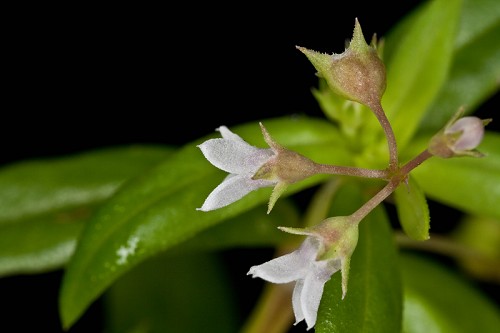Difference between revisions of "Oldenlandia corymbosa"
(→Taxonomic notes) |
(→Ecology) |
||
| Line 36: | Line 36: | ||
Flowers and fruits August through October (FSU Herbarium). | Flowers and fruits August through October (FSU Herbarium). | ||
| − | ===Seed dispersal=== | + | <!--===Seed dispersal===--> |
| − | ===Seed bank and germination=== | + | <!--===Seed bank and germination===--> |
| − | ===Fire ecology=== <!--Fire tolerance, fire dependence, adaptive fire responses--> | + | <!--===Fire ecology===--> <!--Fire tolerance, fire dependence, adaptive fire responses--> |
===Pollination=== | ===Pollination=== | ||
The following Hymenoptera families and species were observed visiting flowers of ''Oldenlandia corymbosa'' at Archbold Biological Station (Deyrup 2015): | The following Hymenoptera families and species were observed visiting flowers of ''Oldenlandia corymbosa'' at Archbold Biological Station (Deyrup 2015): | ||
| Line 46: | Line 46: | ||
Sphecidae: ''Cerceris blakei, C. tolteca'' | Sphecidae: ''Cerceris blakei, C. tolteca'' | ||
| − | ===Use by animals=== <!--Herbivory, granivory, insect hosting, etc.--> | + | <!--===Use by animals===--> <!--Herbivory, granivory, insect hosting, etc.--> |
| − | ===Diseases and parasites=== | + | <!--===Diseases and parasites===--> |
| + | |||
==Conservation and Management== | ==Conservation and Management== | ||
==Cultivation and restoration== | ==Cultivation and restoration== | ||
Revision as of 12:06, 23 March 2016
| Oldenlandia corymbosa | |
|---|---|

| |
| Photo by John R. Gwaltney, Southeastern Flora.com | |
| Scientific classification | |
| Kingdom: | Plantae |
| Division: | Magnoliophyta - Flowering plants |
| Class: | Magnoliopsida – Dicotyledons |
| Order: | Rubiales |
| Family: | Rubiaceae |
| Genus: | Oldenlandia |
| Species: | O. corymbosa |
| Binomial name | |
| Oldenlandia corymbosa L. | |

| |
| Natural range of Oldenlandia corymbosa from USDA NRCS Plants Database. | |
Common name: flat-top mille graines
Contents
Taxonomic notes
Synonym: Hedyotis corymbosa (Linnaeus) Lamarck
Description
"Diffuse annuals or perennials with opposite, sessile or subsessile leaves connected by fimbriate stipules. Flowers axillary or in few-flowered cymes; calyx lobes 4; corolla white, rotate, minute, shorter than the calyx; stamens 4. Capsule enclosed in the calyx, the apex splitting to release the numerous, minute seeds." - Radford et al 1964
"Slender, branched, spreading, glabrous annual with erect or decumbent stems 2-5 dm long. Leaves elliptic to linear-elliptic, the largest 1.5-2.5 cm long, 4-7 mm wide. Flower axillary, peduncles filiform, 5-10 mm long, pedicels filiform, 3-5 mm long; calyx glabrous, 1-1.5 mm long, lobes minute, subulate. Seeds brown, angled, ca. 0.2 mm long or broad." - Radford et al 1964
Distribution
Ecology
Habitat
Oldenlandia corymbosa has been found growing on exposed sandbars in rivers, sidewalk gravel, cracks of concrete, and loamy sand of an open planted peanut field (FSU Herbarium). Soil types include loamy sand, sandy loam, sandy alluvium, and clayey sand (FSU Herbarium).
Phenology
Flowers and fruits August through October (FSU Herbarium).
Pollination
The following Hymenoptera families and species were observed visiting flowers of Oldenlandia corymbosa at Archbold Biological Station (Deyrup 2015):
Halictidae: Lasioglossum lepidii, L. placidensis, L. puteulanum
Sphecidae: Cerceris blakei, C. tolteca
Conservation and Management
Cultivation and restoration
Photo Gallery
Flowers of Oldenlandia corymbosa Photo by John R. Gwaltney, Southeastern Flora.com
References and notes
Deyrup, M.A. and N.D. 2015. Database of observations of Hymenoptera visitations to flowers of plants on Archbold Biological Station, Florida, USA.
Florida State University Robert K. Godfrey Herbarium database. URL: http://herbarium.bio.fsu.edu. Last accessed: October 2015. Collectors: Loran C. Anderson, R.K. Godfrey, Sidney McDaniel, Annie Schmidt. States and Counties: Florida: Calhoun, Franklin, Gadsden, Gulf, Jackson, Lafayette, Leon, Liberty, Suwannee. Countries: Costa Rica, Panama. Compiled by Tall Timbers Research Station and Land Conservancy.
Radford, Albert E., Harry E. Ahles, and C. Ritchie Bell. Manual of the Vascular Flora of the Carolinas. 1964, 1968. The University of North Carolina Press. 981. Print.
